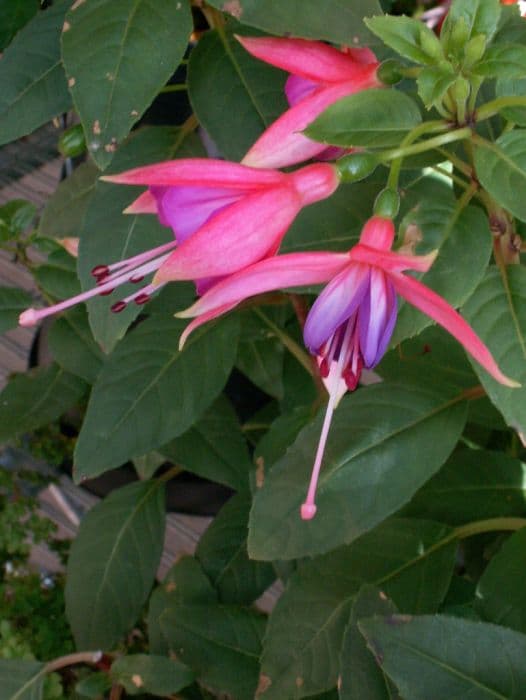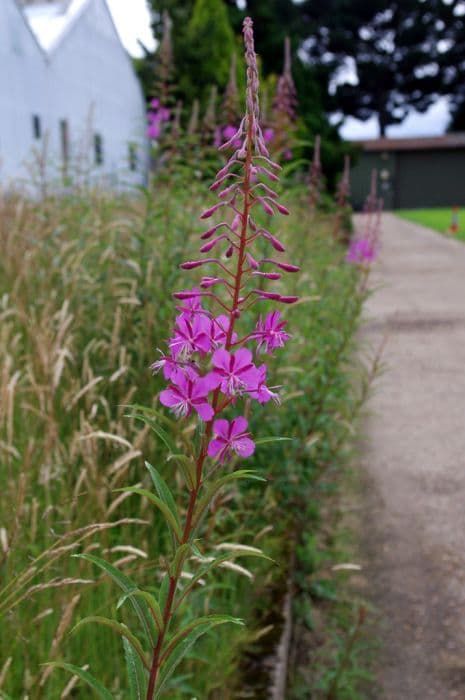Fuchsia Fuchsia 'Pink Fantasia'

ABOUT
The Fuchsia 'Pink Fantasia' is a beautiful ornamental plant known for its striking pendulous flowers, which are a hallmark of the Fuchsia genus. The blooms are mesmerizing, with a unique two-tone color palette that commonly characterizes Fuchsia blossoms. The outer petals are typically a delicate shade of pink, creating a soft and inviting appearance. Contrastingly, the inner petals usually exhibit a vibrant deep pink to purplish hue, which adds depth and drama to the overall look of the flower. These flowers hang gracefully from the branches, sometimes likened to hanging lanterns or dainty ballerinas due to their shape and the way they dance in the breeze. The petals are elongated and can be slightly ruffled, giving them a full, layered look that enhances their ornamental appeal. The stamens often protrude from the petals, lending an additional touch of elegance with their contrasting color and form. The foliage of 'Pink Fantasia' provides the perfect backdrop for the showy blossoms. The leaves are typically a rich, deep green, with a lance-shaped silhouette and a slightly serrated edge. They grow opposite each other along the stems, creating a lush and bushy appearance that nicely frames the flowers. The leaves may also have a slight gloss, catching the light and accentuating the vibrant colors of the flowers. Collectively, the striking flowers and verdant foliage of the Fuchsia 'Pink Fantasia' make it an eye-catching plant that is favored for adding a burst of color and an exotic flair to gardens and outdoor spaces. Its cascading blooms are particularly well-suited for hanging baskets or containers where the full splendor of its drooping flowers can be displayed and admired.
About this plant
 Names
NamesFamily
Onagraceae
Synonyms
Lady's Eardrops, Fairy Bells, Hummingbird Fuchsia
Common names
Fuchsia 'Pink Fantasia'
 Toxicity
ToxicityTo humans
The Fuchsia, including 'Pink Fantasia', is generally considered non-toxic to humans. Ingestion of parts of the plant typically does not lead to poisoning or adverse health effects. Therefore, there are no common symptoms of poisoning associated with the Fuchsia plant when ingested by humans.
To pets
The Fuchsia plant, including the 'Pink Fantasia' variety, is not toxic to most pets such as dogs and cats. It is generally considered safe, and ingestion should not lead to any significant symptoms of poisoning or severe consequences. However, digestive upset is possible if a pet eats a large amount of the plant. If any unusual symptoms are observed, contacting a veterinarian is advisable.
 Characteristics
CharacteristicsLife cycle
Perennials
Foliage type
Deciduous
Color of leaves
Green
Flower color
Pink
Height
1-2 feet (30-60 cm)
Spread
1-2 feet (30-60 cm)
Plant type
Shrub
Hardiness zones
9
Native area
Central and South America
Benefits
 General Benefits
General Benefits- Ornamental Value: Fuchsia 'Pink Fantasia' is prized for its attractive, pendulous flowers, which add a splash of color and visual interest to gardens and landscapes.
- Versatility: This plant can be grown in various settings, including hanging baskets, containers, and borders, providing flexibility in garden design.
- Pollinator Attraction: The bright and vivid flowers attract hummingbirds and butterflies, supporting local biodiversity.
- Long Flowering Season: Fuchsia 'Pink Fantasia' has a lengthy blooming period that extends from spring to fall, ensuring sustained beauty in the garden.
- Shade Tolerance: Unlike many flowering plants, Fuchsia 'Pink Fantasia' performs well in partial shade, making it ideal for cooler, shadier spots where other plants might struggle.
- Relative Hardiness: Although not frost-tolerant, it can be overwintered indoors or in a greenhouse in cooler climates, allowing it to be enjoyed year after year.
 Medical Properties
Medical PropertiesThis plant is not used for medical purposes.
 Air-purifying Qualities
Air-purifying QualitiesThis plant is not specifically known for air purifying qualities.
 Other Uses
Other Uses- Fuchsia 'Pink Fantasia' flowers can be used as a natural dye. The vibrant hues of the petals can impart color to fabrics or inks.
- Petal adornment for culinary presentations, adding a splash of color to desserts and drinks with their edible blossoms.
- Creative arts and crafts such as making flower crowns or adding a touch of nature to handmade greeting cards.
- Used as a live model for botanical illustration and photography, teaching about plant structure and aesthetics.
- Incorporated into miniature gardens or fairy gardens for a whimsical effect due to their delicate and colorful appearance.
- Fuchsia 'Pink Fantasia' can serve as natural confetti for celebrations, weddings, or eco-friendly events as an alternative to paper or plastic.
- They can be floated in bowls of water as a decorative element for garden parties or intimate outdoor events.
- Pressed flower technique can preserve Fuchsia 'Pink Fantasia' blooms for scrapbooking, decoupage, or ornamentation.
- Garnishing cocktails or mocktails, as the nectar-rich blossoms may impart a subtle flavor note to beverages.
- Using the branches and foliage in floral arrangements to add texture and depth alongside other flowers or greenery.
Interesting Facts
 Feng Shui
Feng ShuiThe Fuchsia is not used in Feng Shui practice.
 Zodiac Sign Compitability
Zodiac Sign CompitabilityThe Fuchsia is not used in astrology practice.
 Plant Symbolism
Plant Symbolism- Confiding Love: The dangling blooms of the Fuchsia signify trust and intimacy, representing a deep connection where sentiments are shared.
- Elegance and Grace: The elegant shape and poise of the Fuchsia flowers symbolize high refinement, tastefulness, and a dignified beauty.
- Good Taste: Often associated with sophistication due to its intricate flowers, Fuchsia represents having good taste or appreciation for elegance.
- Ardent Love: The rich colors and the lively appearance of the Fuchsia can signify a passionate emotion, often in a romantic sense.
 Water
WaterFuchsias, including 'Pink Fantasia', prefer evenly moist soil and should not be allowed to dry out completely. During the growing season, water them thoroughly whenever the top inch of soil feels dry to the touch, which may mean watering every few days during hot weather. Depending on the size of the plant and the climate, this could be equivalent to around 16 to 32 ounces of water for a potted fuchsia. In cooler weather or when the plant is dormant, reduce the frequency to once a week or when the soil is noticeably dry. It's best to water at the base of the plant to avoid wetting the leaves, which can lead to disease.
 Light
LightFuchsia 'Pink Fantasia' thrives in bright but indirect light. An ideal spot would be a location that receives morning sunlight and afternoon shade, as intense afternoon sun can scorch the delicate leaves. Hang baskets or place containers in a partially shaded area, like under a tree or on a porch that gets filtered light.
 Temperature
TemperatureThe ideal temperature range for Fuchsia 'Pink Fantasia' is between 60 and 75 degrees Fahrenheit. They can tolerate temperatures down to about 40 degrees Fahrenheit briefly but should be protected from frost. During hot summers, it's important to keep them in a cooler, shaded location to prevent heat stress.
 Pruning
PruningPruning a Fuchsia 'Pink Fantasia' promotes bushier growth and more flowers. Prune in the spring before new growth begins, cutting back about a third of the branches to encourage branching. Throughout the growing season, deadhead spent flowers to maintain a tidy appearance and encourage further blooming. Prune again lightly at the end of the flowering season to prepare the fuchsia for winter.
 Cleaning
CleaningAs needed
 Soil
SoilFuchsia 'Pink Fantasia', commonly known as Hardy Fuchsia, thrives best in a well-draining soil mix composed of loam, peat moss, and sand in equal parts, ensuring good drainage and aeration. The pH preferred by Hardy Fuchsia ranges from slightly acidic to neutral (pH 6 to 7).
 Repotting
RepottingHardy Fuchsias should generally be repotted every 2-3 years, or when they outgrow their current pot, which is normally evident when roots start to crowd or peek through the drainage holes at the bottom of the pot.
 Humidity & Misting
Humidity & MistingHardy Fuchsia prefers a moderate to high humidity level, around 60-70%, to maintain its lush growth and vibrant blooming. Avoiding overly dry air will support the plant's health and flowering capacity.
 Suitable locations
Suitable locationsIndoor
Place Fuchsia in bright, indirect light, ensure high humidity and moderate temps.
Outdoor
Grow in dappled shade, protect from afternoon sun and wind, ensure moist soil.
Hardiness zone
6-9 USDA
 Life cycle
Life cycleThe life cycle of Fuchsia 'Pink Fantasia', commonly known as Fuchsia, begins with germination, where seeds sprout in warm, moist soil conditions, typically in spring. Following germination, the seedling stage involves the development of true leaves and gradual growth into a young plant. As it matures during the vegetative stage, the fuchsia develops a bushy structure with numerous branches and large, dark green leaves. The flowering stage occurs in summer and continues into fall, with the plant producing distinctive, drooping flowers that are pink and purple, attracting pollinators. After pollination, fuchsias produce small fruits containing seeds, completing the reproductive cycle. The plant then enters a period of dormancy in winter, especially in cooler climates, where it may lose leaves and appear to die back, only to regrow from its woody base with the return of warm weather.
 Propogation
PropogationPropogation time
Spring-Early Summer
The most popular method of propagating the Fuchsia 'Pink Fantasia', commonly known as fuchsia, is through softwood cuttings. This technique is best performed in late spring or early summer when the plant has new, green growth. Cut a 3 to 5 inch (about 8 to 13 centimeters) length of stem just below a leaf node, and remove the lower leaves. Dip the cut end in rooting hormone to encourage root development. Then plant the cutting in a pot filled with a moistened mixture of peat and perlite. Cover the pot with plastic to maintain humidity and place it in indirect light. Roots usually develop within 3 to 4 weeks, after which you can gradually acclimate the cutting to normal growing conditions before transplanting.









